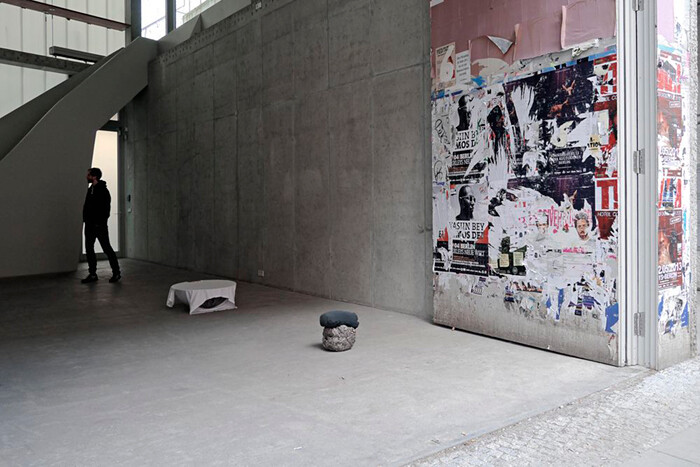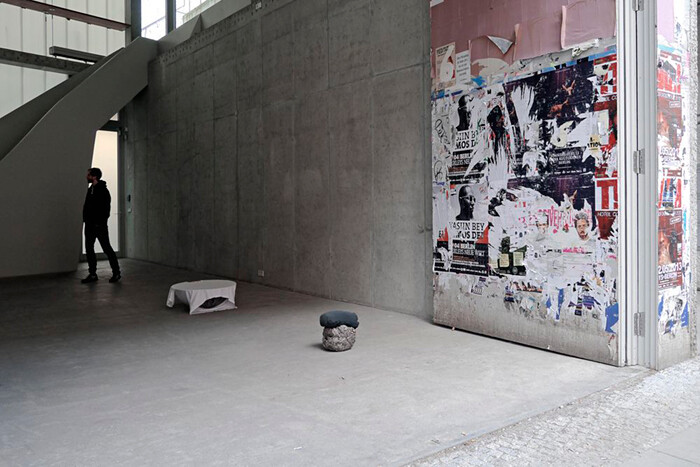Berlin’s been looking downright spiffy lately. Design hotels (to host the import-export set), shiny office buildings (populated by “for rent” signs), and self-important artisanal coffee shops keep popping up. There’s a new Waldorf-Astoria. People dress better. These days, when you call a restaurant, store, or gallery, someone actually answers.
It wasn’t always this way. Berlin in general is “professionalizing” (though I hate that word) and gentrifying (so what else is new?), and its art world is no exception. For the first time in its nine-year history, Gallery Weekend Berlin—an event founded by a small group of gallerists to lure international collectors to the city for a springtime weekend—has appointed a general manager (the affable Cédric Aurelle). This year, nearly sixty drivers in black BMWs spirited VIPs from gallery to gallery. The fifty-one exhibitors ranged from emerging to established. It’s hard to quantify how many art lovers the event now draws, but “we think there were about 10,000 people here altogether,” Aurelle told me as he emerged on Saturday afternoon from the gallery VeneKlasen Werner, looking as if he’d just come from a calming spa treatment. Professional indeed.
As a local, it was the first time I’d done the whole (okay, almost whole) gallery weekend on Gallery Weekend, hitting forty-four galleries, mostly solo shows, in the first two days, replicating the experience of a real, dutiful VIP flying in and out. Seeing it all (or did I really see it?) is a recipe for art overload, but joining the fray offered an opportunity to identify threads that are much harder to see when you take your time.
This year’s edition was refreshingly gender balanced. I counted twenty-four women: some of them icons (Maria Lassnig, Isa Genzken), others rising stars (Aleksandra Domanović, Eva Kotátková, Anna K.E.). Strangely, there was also a solid contingent of old-school Austrians—Lassnig (at Capitain Petzel) is ninety-three; Galerie Cinzia Friedlander showed seventy-two-year-old painter Martha Jungwirth; Valie Export, also a septuagenarian, was on view at Żak | Branicka; and Aurel Scheibler showed the late Curt Stenvert, who died in 1992. Hans-Peter Feldmann’s work was to be found in not one but three different venues (I was told that the tripling of shows was a coincidence). At Mehdi Chouakri, the artist atypically showed only rectangles of light projected onto walls painted blue and green. More familiar Feldmann work was on view at Johnen Galerie (paintings in which traditional motifs are humorously manipulated) and Wien Lukatsch (a trove of printed matter, artist’s books, and photographs).
Also startling was the number of contemporary galleries showing work made decades ago: Sassa Trültzsch presented Roswitha Hecke’s vintage black-and-white photographs of a Zurich sex worker named Irene dating to the late 1970s. Supportico Lopez’s fantastic show of the late Henri Chopin displays the poet’s manuscript La Crevette Amoureuse from 1967/1975; Export’s excellent filmic, photographic, and installation pieces from the 1970s and 1980s constituted a well-curated quasi-retrospective of the feminist artist’s career. Dutch Conceptual artist Jan Dibbets reworked color-swatch car-hood images dating to 1976 at Konrad Fischer Galerie, while Galerie Nordenhake showed a photographic essay that Esko Männikkö and Pekka Turunen produced between 1989 and 1995. Even the gallery lineup has shifted—among notable absences this year were Arratia Beer and Chert, while newcomers included Nature Morte and Kraupa-Tuskany Zeidler, whose nearly invisible location on the fourth floor of an office building off Alexanderplatz was perhaps the oddest venue of all (showing the event’s youngest artist, Avery Singer, an American born in 1987).
The beaten path was well-trod, with herds of viewers passing through Contemporary Fine Arts, Sprüth Magers, Eigen + Art’s sleek white-box renovation (highlighting a sweeping and possibly hard-drive erasing magnetic-pendulum installation by Carsten Nicolai), Esther Schipper’s two-story canal-side space, and Guido Baudach’s new location in the front building of the Tagesspiegel complex on Potsdamer Strasse. On Friday night, a cool crowd gathered at Johann König’s vast St. Agnes space, where Alicja Kwade’s light/sound pendulum Nach Osten (2013), makes the most of the decommissioned Brutalist church’s soaring nave with a reference (sigh) to Foucault’s pendulum. Flashy, but at the same time it felt like something we’ve seen before (a friend quipped, “Ah, swinging light-bulb art!”).
But I found myself lingering longer, and being pleasantly surprised, in quieter outposts. At Circus—a gallery located deep within a landscape of auto repair shops—is a subtle, moving exhibition by German-born Turkish artist Özlem Atlin, whose blurred or doubled photographs, intricately layered collage portraits, or slumping, leaning floor sculptures evoke the tensions between dynamism and fatigue, revealing and concealing. At Wentrup, Nevin Aladağ’s Session (2013) is a hypnotic three-channel video made for this year’s Sharjah Biennial, in which she drags, rolls, or otherwise places musical instruments—a tambourine, drum, rattles, and bells—in urban and rural environments in and around the city. Each instrument represents a Sharjah ethnicity (Pakistani, Indian, Iraqi), making the piece a seemingly unironic portrait of melding cultures, as is the colorful paravent adjacent to it, whose fabric panels are a patchwork of carpet fragments from around the world.
Another surprise was at Aurel Scheibler, the aforementioned Stenvert, who is only recently being rediscovered. The late artist’s production can be neatly divided into chapters: in the 1950s he made films, in the 1960s he turned to three-dimensional collage assemblage, and later still to painting. The hypnotic avant-garde film Der Rabe (1951) is projected onto one wall; dominating the main exhibition space are his Surrealist, neo-Dada assemblages, presented in raised glass vitrines each labeled with a text and an opus number. These combine objects—a guitar with wooden breasts, a tiny kewpie doll—into striking allegories alluding to desire, loneliness, or other universal issues that feel utterly contemporary.
One of the weekend’s most powerful exhibitions was at KOW, which presented the native Detroiter Michael E. Smith’s pared-down object collages. So sparsely installed that they can be difficult to physically locate, the sculptures combine disparate, downmarket everyday objects—a white T-shirt is stretched around a bowl once used to mix bread dough, a flowered pillowcase is tightly wrapped around a canvas, a head-shaped wasp nest is attached to the underside of a plastic chair. The echoes of body parts, the familiar, utilitarian materials exist together but in distant dialogue and eerily evoke the human condition and perhaps even survival in a chaotic world.
One reason Smith’s approach packs so much punch is that it completely lacks the cynicism that seems to be the currency that many younger-generation artists are trading in these days. The clever premise of a show by say, Mandla Reuter at Croy Nielsen, a few blocks away (which is about a letter sent to Los Angeles that was returned with the note “Need Better Address”), feels flippant by contrast.
Which brings up another problem—one of art-world referentiality. In PSM’s new location (a lovely, airy space on Köpenicker Strasse), Ariel Reichman’s exhibition “Dear Felix, I am sorry but we are just too scared to fly,” has the artist painstakingly redrawing, in pencil, Félix González-Torres’s well-known black-and-white photographs of vultures. Funnily, González-Torres is referred to again, with stacks of paper-as-sculpture (albeit piled too high for viewers to take sheets away, González-Torres-style) in Romanian artist Ciprian Muresan’s show at Plan B. Here the press release even reads: “We have all been somewhat reluctantly learning that art does not go anywhere; instead it dances attractively in a circular whirlpool of time. Widespread referentiality in contemporary art finds justification in that.” Muresan is aware of what he’s doing, but we can only wonder: who, beyond smug art-world insiders, really wants to spin around in a temporal whirlpool and end up in a land of repetition?
On Saturday night, hundreds of people gathered for the Gallery Weekend Gala Dinner at Kraftwerk Berlin—a raw Spree-side power plant whose interior makes you wonder what Tate Modern’s Turbine Hall looked like before it was renovated. After dinner, a deep throbbing sound began to emerge from the building’s bowels, which eventually gathered momentum and turned into a monumental light and sound show by Carsten Nicolai. It felt like good old 1990s club-culture Berlin with an added dose of “professionalism” minus the nose rings or torn fishnets. Those of us who actually frequented such places in the old Berlin felt fabulously transported back in time. The imported well-heeled visitors were dazzled by the Berlin-ness of it all—and, after all, Gallery Weekend is, in essence, a showcase meant for them.
Or is it? These fifty-one shows—in sixty-six venues—remain on view for a full exhibition cycle (most through early June) even after the horde of Gallery Weekenders has gone home. Now that the initial commercial push is over, collectors’ dinners eaten, and solid sales made, there’s time and space to contemplate what’s in the galleries as more than commodities or points on a map to check off one’s list. Seeing so many shows in one go is exhausting, but it’s an important exercise in deciphering where Berlin’s art production and consumption is going. Gallery Weekend is an increasingly successful and well-oiled machine, but we can’t forget that it’s also a once-a-year snapshot of Berlin galleries’ and artists’ best efforts, on their home turf, and its multidimensionality makes us hope we end up somewhere after all.













